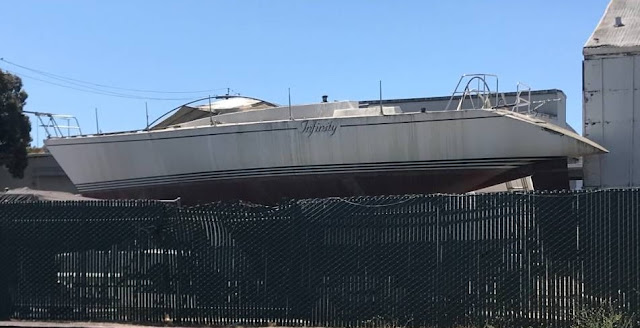 This post features a selection of photographs of the Ron Holland-designed 47-footer Infinity, taken by Phil Uhl and Larry Moran (and some others) during the 1981, 1983 and 1984 SORC. Infinity was commissioned and owned by US yachtsman John B Thomson Jr, and was in some ways a standard design approach for Holland, with a reasonably high freeboard, masthead rig, medium displacement and a flush deck, which was not dissimilar to many of her competitors during that era. She featured a straighter transom than Holland's previous designs which arguably gave the yacht a more elegant appearance than some of his earlier boats that had a pronounced curve in the transom profile. She had a rating of 36.2ft IOR for the 1983 SORC, which was reduced slightly for the 1984 series to 36.1ft.
This post features a selection of photographs of the Ron Holland-designed 47-footer Infinity, taken by Phil Uhl and Larry Moran (and some others) during the 1981, 1983 and 1984 SORC. Infinity was commissioned and owned by US yachtsman John B Thomson Jr, and was in some ways a standard design approach for Holland, with a reasonably high freeboard, masthead rig, medium displacement and a flush deck, which was not dissimilar to many of her competitors during that era. She featured a straighter transom than Holland's previous designs which arguably gave the yacht a more elegant appearance than some of his earlier boats that had a pronounced curve in the transom profile. She had a rating of 36.2ft IOR for the 1983 SORC, which was reduced slightly for the 1984 series to 36.1ft.
Infinity finished 10th in Class B in the 1981 SORC series (after placings of 6/7/10/11/14/13). She was fourth in Class B in the 1983 series (after placings of 6/7/1/5/1/3), behind a trio of Frers 51 yachts Carat, Bla Carat and Zero, and finished 33rd overall. In 1984 she came up against the likes of the Frers 50s Morning Star and Retaliation, and the Peterson design Artemis in Class B, and finished eighth, and was 42nd overall.
 |
A photo of Infinity in a nice upwind mode during the 1981 SORC (photo Guy Gurney | Facebook)
|





 The J/41's were also noted for their structural integrity, when five survived the rough 1984 Bermuda Race, and two survived the SORC that year without failure. Construction nevertheless pushed the limits of the time, utilising vacuum bagged unidirectional aircraft-grade Baltek Contourkote sandwich and 1/8th inch unidirectional carbon fibre skins for increased rigidity and impact resistance in critical areas.
The J/41's were also noted for their structural integrity, when five survived the rough 1984 Bermuda Race, and two survived the SORC that year without failure. Construction nevertheless pushed the limits of the time, utilising vacuum bagged unidirectional aircraft-grade Baltek Contourkote sandwich and 1/8th inch unidirectional carbon fibre skins for increased rigidity and impact resistance in critical areas. 























